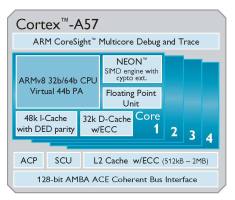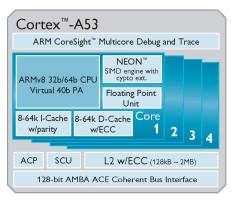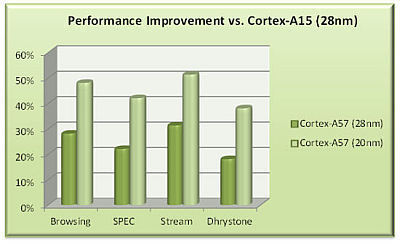ARM introduces Cortex-A53 and Cortex-A57 64-bit processor cores

![]() Cortex-A57: 64-bit and 32-bit processing, up to four cores, 44-bit memory management
Cortex-A57: 64-bit and 32-bit processing, up to four cores, 44-bit memory management
Source: ARM
After releasing plans for the ARMv8 64-bit micro architecture a year ago, UK-based semiconductor developer ARM has now announced actual implementations: the Cortex-A57 and the Cortex-A53. Both implementations can be used on their own or work together according to the big.LITTLE processing concept to increase chip efficiency when processor loads are low. The new CPU cores will initially target highly integrated server SoCs and can be combined with CoreLink components; this allows multiple chips or CPU cores to be linked together tightly and coherently. Powerful and energy-efficient cluster interconnects are expected to be pivotal for the future success of certain microprocessors.
Unsurprisingly, ARM lists AMD among the first licensees of the Cortex-A50 core series – the company plans to integrate them into future Opterons, where they will cooperate with SeaMicro's Freedom Fabric – but the list also includes Broadcom, Calxeda, HiSilicon, Samsung and STMicroelectronics. Calxeda has released 32-bit EnergyCore processors that run in HP's Moonshot pilot project. AppliedMicro has implemented an ARMv8 core in a field-programmable gate array (FPGA) which the company uses to develop (Linux) software; first X-Gene chips could be launched before the end of the year. AppliedMicro is cooperating with ARM and Red Hat to develop a Fedora 19 AArch64 "remix".

![]() Binary-compatible with the A57, the Cortex-A53 is intended not only as a junior partner, but also as a stand-alone core for low loads
Binary-compatible with the A57, the Cortex-A53 is intended not only as a junior partner, but also as a stand-alone core for low loads
Source: ARM
ARM says that the Cortex-A57 will offer performance improvements of up to 30% over a Cortex-A15 when implemented in the same 28-nm technology; 20-nm versions are said to be as much as 50% faster. However, Cortex-A57 SoCs will likely only become commercially available in 2014 – this has for years been ARM's target for the first server SoCs that have their own micro-architecture. Intel, however, won't surrender the micro-server field without a fight and plans to have released the second generation of server Atoms by then. HP recently estimated that micro-servers with Atom or ARM SoCs could claim about 15 per cent of the server market by 2015. However, the development of such SoCs isn't cheap, even if ARM components are used; originally founded as SmoothStone by former Marvell, Intel (XScale), AMD and Newisys employees in 2008, Calxeda has since received $100 million in venture capital.

![]() A Cortex-A57 built in the same 28-nm technology is said to be up to 30 per cent faster than a Cortex-A15
A Cortex-A57 built in the same 28-nm technology is said to be up to 30 per cent faster than a Cortex-A15
Source: ARM
According to a blog posting, the Cortex-A53, code-named "Apollo", shares the same 8-stage pipeline and in-order structure as the Cortex-A7, which can also be the Cortex-A15's big.LITTLE partner. The Cortex-A15 has first been used in end products in Google's new Chromebook and in the Nexus 10; both devices are produced by Samsung and probably include Exynos 5 SoCs.
(crve)
![Kernel Log: Coming in 3.10 (Part 3) [--] Infrastructure](/imgs/43/1/0/4/2/6/7/2/comingin310_4_kicker-4977194bfb0de0d7.png)

![Kernel Log: Coming in 3.10 (Part 3) [--] Infrastructure](/imgs/43/1/0/4/2/3/2/3/comingin310_3_kicker-151cd7b9e9660f05.png)
















